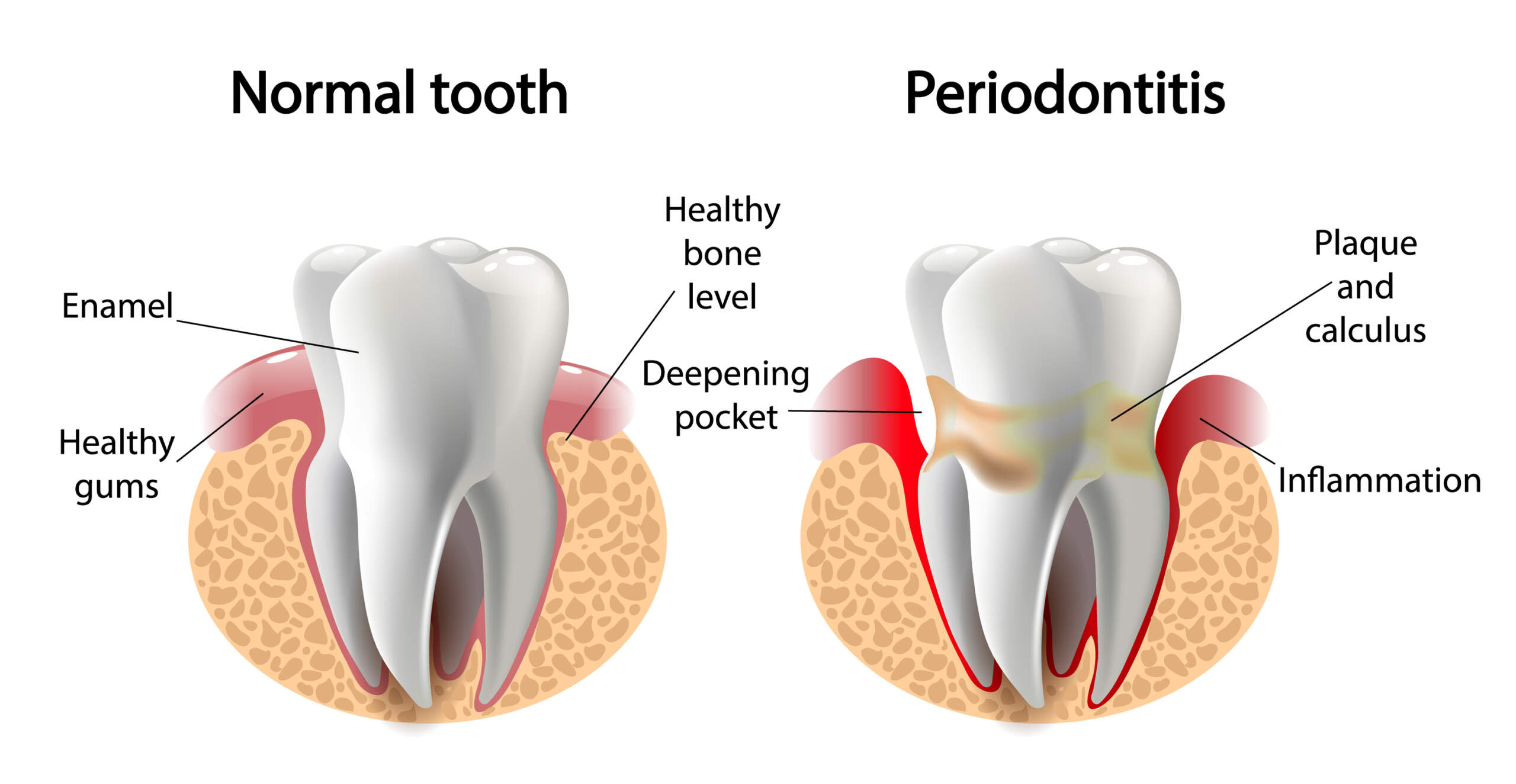Periodontal or gum disease is an infection of the soft tissues that hold your teeth in place. Gum diseases, without proper and immediate treatment, can destroy the bone that supports your teeth.
Gum diseases can also cause teeth to loosen, eventually leading to tooth loss. Periodontal diseases are typically caused due to poor oral hygiene and poor brushing and flossing habits that allow plaque, a sticky film of bacteria, to build up on the teeth and get hardened.
Periodontal disease can lead to sore, bleeding gums, painful chewing and bite problems, and even tooth loss in advanced stages.
- Bad breath or bad taste
- Red or swollen gums
- Tender or bleeding gums
- Painful chewing
- Loose teeth
- Sensitive teeth
- Gums that have pulled away from teeth
The main cause of gum or periodontal diseases is the presence of bacteria in the mouth for prolonged periods. This infects the soft tissues surrounding the tooth and causes inflammation.
When gum diseases do not get appropriate treatment in the initial stages, the bacteria convert into a film called plaque, which eventually hardens to tartar. Tartar build-up, when spread below the gum line, makes the teeth harder to clean, and such oral problems need immediate professional help.
PROCEDURE FOR THE DIAGNOSIS OF PERIODONTAL DISEASES:
The diagnostic procedure holds significant importance in the treatment of periodontal diseases. The diagnosis process generally includes the evaluation of your medical history, examination of your mouth, and the assessment of the extent of plaque build-up through a series of X-rays or radiographs.

TREATMENT OF PERIODONTAL DISEASES:
The treatment of periodontal diseases can either be surgical or non-surgical, depending on the extent of your oral problem. Periodontal diseases are generally treated by a dentist, a periodontist, or a dental hygienist.
The main goal of periodontitis treatment is to deeply clean the pockets around the teeth and prevent the spread of infection to the surrounding bone.
You can easily eliminate such oral conditions if you also adopt a healthy oral routine by brushing and flossing your teeth regularly and minimizing the consumption of nicotine or tobacco.
Some common treatments for gum diseases are as follows:
NON-SURGICAL TREATMENTS:
If the gum diseases are in the initial stages, they can be treated through non-invasive and non-surgical treatments, including:
1. SCALING
Scaling is a type of non-surgical treatment of periodontitis. Its procedure includes the removal of tartar or bacteria from the tooth surfaces beneath the gums. Scaling is generally performed by the utilisation of instruments like an ultrasonic device or a laser.
2. ROOT PLANING
Root planing is another type of non-surgical treatment for periodontitis. It smooths the root surfaces, discouraging further buildup of bacteria and tartar and removes bacterial byproducts that become a reason for inflammation.
Such bacterial byproducts also delay healing or reattachment of the gum to the tooth surfaces and must be eliminated as soon as possible.
3. ANTIBIOTICS
Antibiotics also help in controlling bacterial infection. Topical antibiotics generally include mouth rinses or gels that are inserted in the spaces between your teeth and gums. These gels contain antibiotics that deep clean the pockets accumulated with bacteria.
SURGICAL TREATMENTS:
If periodontitis or gum diseases exceed advanced stages, they can no longer be eliminated by non-surgical treatments and require complex surgical procedures, which involve:
1. FLAP SURGERY
In the flap surgery, the periodontist makes tiny incisions in the gums so the affected section of gum tissues can be lifted back, exposing its roots. Because periodontitis often becomes a reason for bone loss, the underlying bone may be recontoured before the gum tissue is sutured.
After you heal, cleaning the infected areas and maintaining healthy gum tissue becomes much easier.
2. SOFT TISSUE GRAFTS
When the periodontitis is left untreated for extended periods, the gum tissue is lost, which leads to gum line recession. You may need to have the damaged soft tissue reinforced in such cases.
This procedure is usually carried out by removing a small amount of tissue from the roof of your mouth, also called the palate. This can help reduce gum recession, cover exposed roots, and provide you with a more pleasing appearance.
3. BONE GRAFTING
Bone grafting becomes necessary when periodontal or gum diseases reach the final stages and destroy the bone surrounding the tooth root. The graft may be composed of small fragments of your bone, or the bone may be donated or synthetic.
The bone graft treatment helps prevent tooth loss by holding your tooth in place. It also serves as a platform for the regrowth of the natural bone.
APPROXIMATE COSTS OF PERIODONTAL TREATMENTS:
The estimated costs for periodontal or gum treatments are mainly dependent on two factors, including the extent of your oral condition and the type of procedure involved in the treatment processes.
On average, periodontal treatments can cost you around $1700 to $8000. The first approach in the treatment of periodontal diseases is root scaling and planning. If the problem has reached advanced stages, then these procedures do not help, and surgery is needed, potentially using pocket reduction or bone grafting methods.
The approximate costs of periodontal therapy are between $400 to $5000, implant placement can cost you around $2000 to $4000 per implant, and the costs of periodontal surgery range between $600 to $3000. The estimated costs of stage grafting are between $1500 to $3500.











